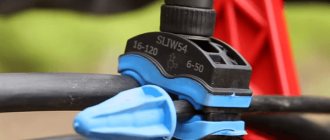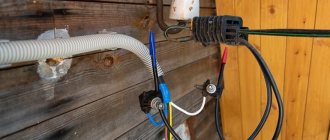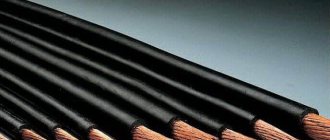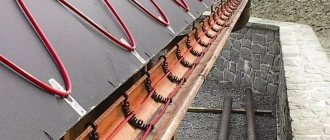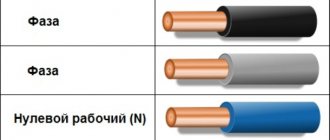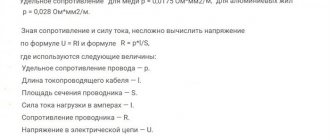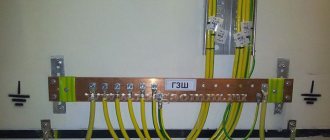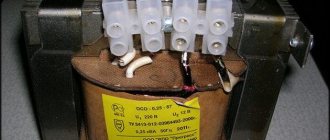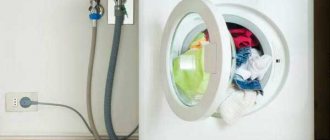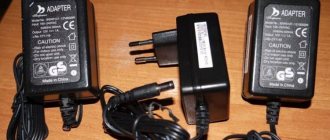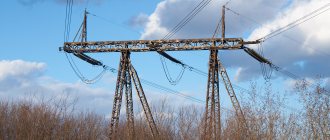Estimated reading time: 9 minutes(s) Which cable should I use to connect the speakers? The question is standard and reasonable, when you already understand that using an acoustic wire with a cross-section of 0.3-0.5 mm2 is not a sound idea. And you already know this, because earlier there were articles here - How to choose a cross-section for an acoustic cable? and Which wire is better to connect the acoustics?
But here another strange question arises for some: “Which cable should I use to connect the acoustics - single-core or multi-core ?” It’s strange, but this question arises among music lovers, mainly among beginners. In addition, there is a lot of debate on this topic among professionals, oddly enough. And today I will express my vision about this.
Welcome to our website. Let's go, let's talk about this topic. Let's look at the measurements and draw conclusions. The topic allows for an interesting conversation.
Prelude to a conversation about wires
Let's compare single-core and multi-core cables.
Which one can conduct sound better to the speaker system? Which one will be the best speaker to play on? Strange questions, but they are asked. Some say that multi-core transmits the signal from the amplifier to the acoustics better, others argue with them. All of us, one way or another, studied physics at school. Therefore, we still have a general idea of what cross-section, thickness, current and voltage are, as well as resistance. Therefore, let’s take two two-wire cables, three meters long, and continue our reasoning.
Solid wire
One will be single-core, as in the picture below - VVG 2*2.5. This type of wire is used by electricians when laying electrical wiring (in a house, apartment) in a groove where wiring of a grounding conductor is not required. That is, they lay it in such a way that it will no longer be exposed to external influences.
In other words: it will not bend and bend many times. Just as they laid it, it will be walled up in the wall. This is the right decision, since it is possible to lay stranded wire in grooves, but this will be very inappropriate due to the cost of stranded wire.
Stranded wire
The second wire will be multi-core - PVA 2*2.5, as in the picture below. It is usually used in extension cords and when connecting any devices and appliances to the electrical network.
So, we took two different wires VVG 2*2.5, three meters long, and PVS 2*2.5, the same length. Their cross-section, according to the passport, is 2.5 square (mm2).
How to measure the cross-section of a stranded wire? There are no difficulties - you just need to find out the thickness of one “hair” from this wire, and then count the number of these same wires. Next, multiply the number of wires by the diameter of one “hair”. We will take measurements with a micrometer and use the formula.
Single-core and multi-core cable? Which to choose?
Further, the short service life of the PVS cable is due to the fact that when used for its intended purpose (as a flexible cord), despite its increased flexibility, it will still be subject to mechanical wear, and both the insulation and conductors will sooner or later be damaged. But if it is used for stationary installation, then it will not be subject to mechanical wear and its service life will be no less than the same VVG. Therefore, the myth that the service life of a flexible cable specifically for stationary installation is less than that of a cable with a monocore - this is just a misconception that stems from a simple misunderstanding of the essence of the issue. I will say more - a cable with stranded conductors also has a number of advantages over a cable with a monocore: 1. With the same cross-section of the conductor, the current density and load capacity of a stranded wire is greater than that of a wire with a monocore. 2. Due to its flexibility, it is more convenient to install, especially in the switchboard and socket boxes. But there are also disadvantages to using a cable with stranded conductors: 1. The need to use sleeve lugs or solder the ends when connecting. 2. Higher price in relation to a cable with a single core with the same cross-section. I will say more for those who are not in the know - in critical places - for example in airplanes, flexible conductors of increased flexibility with very thin veins are used - thereby ensuring increased wear resistance and resistance to fracture from all kinds of vibrations. It is precisely because of vibrations that only stranded conductors are used in mobile vehicles in those places where it is impossible to rigidly fix the wiring and their service life will be much longer than that of a cable with a monocore.
Comparison of the thickness of solid and stranded wire
We measure the thickness of the conductors and carry out calculations using the formula shown in the picture below. Everything seems clear.
In this case, our single-core VVG 2*2.5 has a cross-section of 1.76 mm. Formula S = 0.785*D2. We substitute the data: S = 0.785, multiply by 1.76 and again by 1.76. It turns out - 2.43 mm2. Almost exactly, but the data sheet for this wire says 2.5.
Multi-core PVA 2*2.5. We measured one thin vein and hope that it has a diameter of 0.25 mm. Further, according to the formula: S = 0.785 * 0.25 * 0.25, S = 0.049. And in total there are 50 such small veins. This means that we multiply the figure obtained in the formula by the number of veins - by 50. As a result, we get - 2.45 mm2. The passport for the PVA wire indicates 2.5.
Well, we will assume that everything matches and the wires have the same cross-section.
Comparison of resistance of single-core and stranded wire
Not every tester will be able to capture the measured resistance parameters. The measured resistance is so small that the results obtained are on the verge, or even more, of the error of a simple tester. We will measure with a milliohmmeter; it has a special purpose - to measure very small resistances and the error is sufficient for such measurements.
Milliohmmeter
Resistance measurement of single-core VVG 2*2.5
The first in line will be single-core VVG 2*2.5. Let's measure the resistance of one conductor 3 meters long. Resistance – 22.1 mOhm. The second conductor has a slightly different resistance - 21.8 mOhm. For the purity of measurements, we will measure the total resistance of the two wires: we will connect the wires at one end, and apply the tester probes to the other end of the wire.
It turns out that the cable, with the ends connected on one side, with a total conductor length of 6 meters, has a resistance of 44.1 mOhm .
Resistance measurement of stranded PVA 2*2.5
This time, we will immediately twist the ends of the cable on one side and measure on the other. The cable is three meters long, the total length is six meters. As a result, the resistance of the PVA wire is almost the same as that of a single-core VVG wire - 44.5 mOhm . This concludes the measurements and comparisons of resistances.
Comparison test of TTAF monocore cables
Share
The recipe for “listening” to cables is simple - in order to truly hear the sound characteristics of a particular cable, you need to place it in a familiar system, warm it up and then listen to familiar musical material.
We have two interesting cables from TTAF - both belong to the “silver” line, both are in approximately the same budget and both are monocores. The sound advantage of a monocore compared to a traditional multicore conductor can be generally described as “a more monolithic sound and denser bass.”
But the monocore in these cables is different: in the TTAF 93144 cable it is a round, thick central conductor in a classic coaxial environment, but TTAF 93004 is more progressive - a flat monocore surrounded by an air dielectric with a honeycomb insulation design:
In order to hear all the nuances of the sound of these cables, they were placed in a test system of excess level: a tube circuit with an Octave amplifier, Gamut Phi 5 acoustics and sources - a CEC TL51X CD player with a belt drive, a Roxanna vinyl player with a Shure V15 Type III cartridge and a purely digital source - Cabasse stream via NAD 50 DAC. The cost of the system, depending on the components, ranges from 10 to 18 thousand dollars - it is obvious that it will be able to reveal all the details of these cables.
The speaker cable used as a reference in this system is Ecosse SMS, costing about $400/m
As a result of a long test, the following results were obtained
Test TTAF 93144 Advantages: Softness, musicality, emphasis on the velvety middle. Disadvantages: Narrowed dynamic range, sluggish speed. Conclusion: A good solution for budget systems with enhanced sound. A very good solution for so little money.
Test TTAF 93004 Advantages: Smoother and more transparent sound compared to 93144, excellent tonal balance, full dynamic range - no sound embellishment. Good speed. Disadvantages: roughness of the upper middle. Conclusion: This cable will “revive” a system with a lack of volume and give it additional airiness.
The general conclusion for both cables is that these cables will provide healthy competition for cables in the price range of $150-200 per meter pair.
Addition. After this test, our client decided to personally verify the difference in the sound of these monocores. And this is what he wrote after his own test on Denon monoblocks: _ “The TTAF 93144 cable transmits music softly and emphasizes detail due to a slight HF accent. Wonderful cable, we did a test comparison with Atlas for $200, TTAF 93144 performs equally or even better! If anyone’s source/amplifier produces a not-bright “muddy” sound, then I definitely recommend 93144!
The TTAF 93004 cable is more dynamic and musical compared to the TTAF 93144. There are no embellishments and no emphasis on high frequencies, it plays beautifully. Perfect for tube technology and for Jazz, Bluze, and instrumental music. Both cables perform much better than their price, I recommend them to everyone!”_
Cable power loss measurement
Let's try to measure losses in the cable under load, at different frequencies. Using an amplifier with a power of one hundred watts, we measure the losses at the beginning and end of the wire. We will supply signals of different frequencies to the input of the amplifier from the frequency generator. Adjust the amplifier volume control to the maximum volume position.
Stranded wire
Let's connect the ends of the multi-core PVS cable to the output of the amplifier, and connect the other ends to the load in the form of powerful resistances - 4 ohms.
Let's set the frequency on the generator to 20 Hz and the voltage value such that the output of the amplifier would be a signal of 100 watts. At the output of the amplifier the measured voltage is 20 volts. At the other end of the wire, where the load is connected to the wire, there is 19.7 volts. The loss in the wire is 0.3 volts.
Now we set the frequency at the generator output to 1 kHz. We measure the signal with an oscilloscope at the output of the amplifier, where the wires to the acoustics are connected (in our case, a load in the form of 4 ohm resistances). It turns out that the minimum value before signal clipping is 20 volts. Then we measure with oscilloscope probes the places where the wire is connected to the load. There the oscilloscope shows a certain voltage drop - 19.7 volts. The loss in a multi-core PVA, three-meter wire, is 0.3 volts.
We will also take measurements at 20 kHz . The output of the amplifier is 20 volts. At the end of the wire where it is connected to the load - 19.5 volts. It turns out a little more than in earlier measurements at other frequencies. Lost - 0.5 volts.
Solid wire
We connect the PVS-VVG cable to the amplifier, and the other end to the load. We carry out the same measurement operations at frequencies of 20 Hz, 1 kHz and 20 kHz.
20 Hz: output – 20.1 volts, at the point of connection to the load – 19.8 volts. The loss in the wire is 0.3 volts.
1 kHz: amplifier output – 20.1 volts. The output from the wire is 19.8 volts. Loss - 0.3 volts.
And the last measurement was at a frequency of 20 kHz . The output of the amplifier is 19.9 volts. At the load connection point (at the other end of the wire) - 19.4 volts. The resulting loss is exactly the same as in measurements with a stranded wire - 0.5 volts.
Results of measurements of losses in wires - single-core and multi-core
The cross-section of the wires is the same as for multi-core PVA 2*2.5 and for single-core VVG 2*2.5. Although this may differ in another measurement, with other cable manufacturers. In our case, everything is at the level of errors.
The resistance of both wires is almost the same (44.1 and 44.5 mOhm), again on the verge of errors.
The tested wires, with a signal at different frequencies (20 Hz, 1 kHz and 20 kHz), behave exactly the same! The loss at three meters, at frequencies of 20 Hz and 1 kHz is 0.3 volts, and at a frequency of 20 kHz - 0.5 volts.
